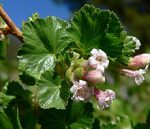 Also known as white-flowered currant, wax currant, and western red currant, this deciduous spreading or erect shrub is native from British Columbia to northern California east to Montana, Nebraska, Colorado, and New Mexico where it grows in dry woods and on rocky slopes. It is a member of the currant family, Grossulariaceae, that consists of one genus with about 200 species that are currants or gooseberries. Plants grow 4-6′ tall and are densely branched with thornless stems that have cherry-like bark. The rounded leaves are .4-1.6″ across and have 3-5 shallow lobes with bluntly toothed margins. They are waxy and gray-green on the upper side and downy gray on the lower side before turning yellow in the fall. In early summer, drooping clusters of 2-9 tubular flowers appear. They are 2-3 inches long and composed of greenish-white to pink petal-like sepals and inconspicuous white to pink petals. The fruit is a shiny red to orange berry that may be flavorful and are loved by birds. Plants are drought tolerant and useful as a hedge. The genus name, Ribes, comes from the Arabic or Persian word ribas meaning acid. The specific epithet, cereum, is the Latin word for waxy, and refers to the covering on the upper surface of the leaves.
Also known as white-flowered currant, wax currant, and western red currant, this deciduous spreading or erect shrub is native from British Columbia to northern California east to Montana, Nebraska, Colorado, and New Mexico where it grows in dry woods and on rocky slopes. It is a member of the currant family, Grossulariaceae, that consists of one genus with about 200 species that are currants or gooseberries. Plants grow 4-6′ tall and are densely branched with thornless stems that have cherry-like bark. The rounded leaves are .4-1.6″ across and have 3-5 shallow lobes with bluntly toothed margins. They are waxy and gray-green on the upper side and downy gray on the lower side before turning yellow in the fall. In early summer, drooping clusters of 2-9 tubular flowers appear. They are 2-3 inches long and composed of greenish-white to pink petal-like sepals and inconspicuous white to pink petals. The fruit is a shiny red to orange berry that may be flavorful and are loved by birds. Plants are drought tolerant and useful as a hedge. The genus name, Ribes, comes from the Arabic or Persian word ribas meaning acid. The specific epithet, cereum, is the Latin word for waxy, and refers to the covering on the upper surface of the leaves.
Outstanding Feature: Flowers, berries
Form: Sprawling or erect
Growth Rate: Rapid
Bloom: Clusters of greenish white to pink tubular flowers in early summer
Size: 4-6′ H x 4-6′ W
Light: Full sun
Soil: Average, dry to medium moist, well-drained
Hardiness: Zones 5-8
Care: In late spring prune out the oldest branches to the ground to encourage new growth.
Pests and Diseases: None of significance
Propagation: Seed, layering, cuttings
Photo Credit: Wikipedia